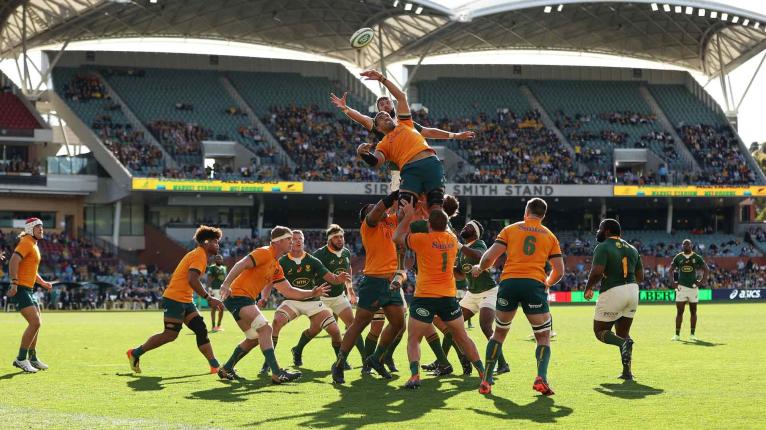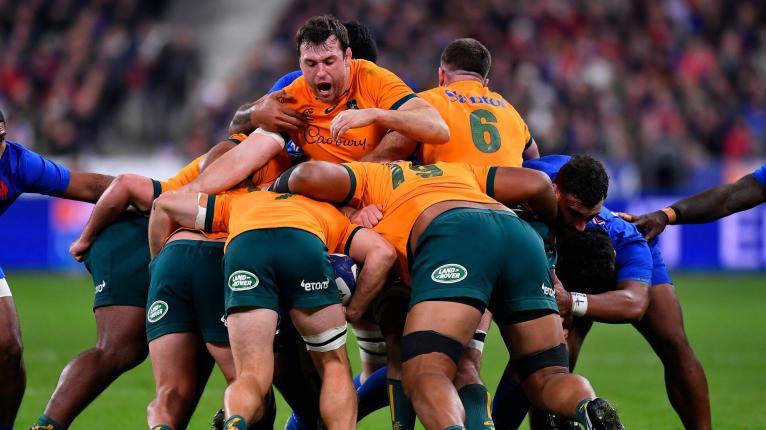The breathless expectation has finally come to an end. The ribbon has been cut, the bottle of champagne – well, maybe a decent Prosecco – has smashed against the hull, and the good ship S.S. Wallaby has finally been launched down the slipway to success, or otherwise, at the 2023 World Cup.
Eddie Jones has announced his first Wallaby squad of the season, and the shape of his thinking for the biggest competition in the global game has become just a little bit clearer.
In order to succeed in September, Jones will need to be able to win the battle of the big men in the second row and at number 6, because that is where the vast majority of lineout ball will be won. The lineout is statistically around three to four times more important than the scrum as a launchpad for attacking play in the modern professional game.

During what turned out to be Dave Rennie’s farewell season, it was one of Australia’s biggest Achilles heels. At the 2022 Rugby Championship, Australia finished dead last with an 80.7 per cent retention rate on their own ball, and (along with the Pumas) the lowest ratio of takeaways on the opposition throw.
It all seemed an awfully long way from the golden years of the John Eales/David Giffin era back in the early 2000s, when Australia fielded probably the best lineout in the world.
Before the series against England back in July, then-forwards coach Dan McKellar proclaimed, “We’re trying to develop a mindset here of having the best maul in the world.
“The reality is Test match games are often tight … opportunities are less, but when we do take them, we’ve got to be better.
“Mauling’s one part of it, there’s a whole lot to being a good forward pack, but it’s an area that we’ve identified that can certainly make some shifts.”
It looks as if Eddie Jones will be rearranging the same pieces on his chess board come the World Cup.
It was a laudable aim, but it never materialised. Not in that England series, where the tourists’ lineout bullied its way to victory in the second or third Tests; certainly not in the Rugby Championship later in the year, when the Wallabies’ close-range driving maul was only a weapon in the first-round match against Argentina.
Sprigs of green growth only appeared on the November tour, with the introduction of young 6-foot-9-inch giant Nick Frost providing a new focal point for lineout success. Although he had been playing behind Darcy Swain during the domestic Super Rugby Pacific season with the Brumbies, Frost turned out to be the biggest ‘find’ of the tour.
He was the only forward to play every minute of every Test and he made the most carries and tackles by any Wallabies forward. He won half of all Australia’s lineout ball, and he conceded one solitary penalty in four matches. Frost was disciplined, athletic, and indefatigable.
It looks as if Eddie Jones will be rearranging the same pieces on his chess board come the World Cup: Frost, Swain, Caderyn Neville and Jed Holloway are his picks after six rounds of Super Rugby Pacific this year, with Matt Philip and Izack Rodda on the long-term ‘injured reserve’ list, and Will Skelton and Rory Arnold’s twin brother Richie looking in on Zoom from their adopted rugby homes in France.
Frost has added lineout calling to the already extensive list of strings to his bow in 2023, and he has made a very decent fist of it. The Brumbies ranked first in own-ball lineout retention at 89 per cent after five rounds, second only to the Crusaders in their ratio of steals on opposition ball.

The Waratahs’ Jed Holloway may be sitting amid a hornet’s nest of Brumbies in terms of second-row selection, but he gave Eddie Jones a forceful and timely poke in the ribs during last weekend’s derby between the rivals from Canberra and New South Wales.
Holloway is becoming the Reece Hodge of the Australian pack, able to manage four of the spots in the back five forwards, shifting between lock and blindside flank as required; calling the lineout from number 6 on the November tour, able to play wide in the 15-metre channels or tight in traffic between them. ‘Versatile’ is just another word for ‘indispensable’.
Alongside Rob Valetini, Jed Holloway is one of Australia’s top two high ‘choke’ tacklers in defence; as befits a man who started Super Rugby life at number 8, he can bust the line and make the hard yards up the middle on attack: here he is at Eden Park, making a midfield stop at 0:17 on the game-clock and busting the line only half a minute later [at 0:45].
Holloway can also do a lock’s bread-and-butter. After five rounds of Super Rugby, he ranked third behind Frost and Neville with 25 own-ball lineout takes, and joint first in steals (along with Frost) with four. He is the best maul-stopper in Australia, and his work in that respect bears comparison with two of the very best Australians plying their trade outside the country, Will Skelton and Rory Arnold.
And so it was that Jed Holloway was able to give Nick Frost, Caderyn Neville and the rest of the Brumbies lineout more trouble at GIO Stadium than it had experienced at any time since the round two game against the Blues on 5th March.
He gave them problems to solve in the air, and he created even more on the ground when the men from Canberra indulged their favourite lineout drive from five metres – the ploy which, as Dan McKellar rightly said, has to work if you are going to convert a goodly proportion of opportunities into tries in the red opposition zone.
Holloway began by giving Nick Frost plenty to think about in the air:

In both of these lineouts, Nick Frost is walking in as the last man, and Holloway is watching him all the way. The two lifters on either side of him (Taleni Seu and Harry Johnson-Holmes in the first instance, Tetera Faulkner and Johnson-Holmes in the second) are committing early as Frost enters the line.
They know it will be a contest straight-up, with minimal movement to disguise the true target area for the throw. Holloway edges forward of Frost in both examples, so that he can intercept it before it reaches the highest point of the curve and Frost moves into his own world, an unreachable stratosphere.
When Frost did try to use a little motion before the throw to offset his opposite number, Holloway made an excellent read:
Pete Samu pulls up the line and Frost drops down one spot to the front, but Holloway reads the play ahead of time to become a back-boost for Ned Hanigan.
If Holloway’s aerial defence against a man four inches taller was good, his defence on the ground against the formation of an effective maul was even more impressive:

As soon as Holloway gets a hand through on to the second layer of the drive, it is time to think about moving the ball away via the back-line, and that is not what the Brumbies really want to do. The opportunity at one end finishes as a chance at the other after a Brumbies’ fumble and a long breakaway down the left touch by Lalakai Foketi and Max Jorgensen.
The big man’s ability to stand strong in the middle of the drive and split the main blocking seam was a constant thorn in the Brumbies’ side:
In both these examples, Holloway – aided and abetted by Harry Johnson-Holmes – has broken the bind between the receiver (Neville) and his primary blocker (Frost) completely, and worked his way all the way through onto the ball-carrier at the back of the drive. It is ‘dog work’ of the finest and most magnificent kind.
Even with both of their tight-head props off the field and New South Wales down to six forwards, the Brumbies could not score from their favourite tactic legitimately:

The only way the men from Canberra can remove Holloway from the play is to have Caderyn Neville block him out illegally in front of the catcher, and the ‘try’ was rightly marked off for obstruction.
There are already three second rows from the Capital Territory in Eddie Jones’ new Wallaby squad, with another ex-Brumby (Richie Arnold) looking on from afar via Zoom. But it is New South Welshman Jed Holloway who made the biggest impact at GIO Stadium last weekend. With Richie’s brother Rory momentarily out of the reckoning and Will Skelton playing in France, he is the best home-grown maul-stopper in the country.
Like Reece Hodge in the backs, he is Australia’s Mr Fix-It up front; able to swap between rows of the scrum and call lineouts; to play tight or wide, on attack or in defence. While Nick Frost may be the fastest riser among the younger fraternity of Australian forwards, the value of players like Hodge and Holloway will grow as the World Cup approaches. Maybe ‘versatile’ really does mean ‘indispensable’, and the word is not such a curse after all.



Nice piece Nick as always. 6 has been a problem area for the wallabies and many seem unconvinced by Jed, but I think part of it is because he does so much of that unseen work. I'd like to see him starting at 6 or he would also be a very good bench forward.
I thank the (rugby) gods you are still scribing, NB! The Roart is a mess. Very happy to have relocated here as well. We just don’t have the depth of locks to ensure the power game is sustainable. Not based on MrEd’s current trajectory anyway.
“A hornets nest of brumbies”; “Reece Hodge of the Australian pack” nice 👌
Nice piece Nick. Likewise, I've been increasingly impressed with Jed's form, through last year at the Tahs, on tour, and now he's started strongly again this year. Strikes me as a leader. Could be a good captain of the Tahs, if not higher honours.
How good is to see that lineout maul blocker being penalised on a regular basis.
Thought the partnership with Hanigan was particularly good on Saturday, esp working with a narrowed up loose trio.
Thank you NB for the read. Would Eddie Jones be looking at Holloway as his 6 with Frost kept as a lock?
Thanks Nick
Agree re Holloway.
Away from the lineout he is also a complete player, who can catch/pass, run, step, tackle, work hard.
When he was just an 8, he had many of these skills, but appeared lazy.
Clearly Eddie is targeting the lineout as he is with other set pieces. But having the best locks in the world is pointless if your hooker couldn't throw a watermelon into an open wheelie bin.
Cheers Nicholas. Interesting to see how things progress over the Super Rugby season with form and injuries, but clearly you are right at the moment.
I was thinking Jacob's Sparkling Chardonnay!